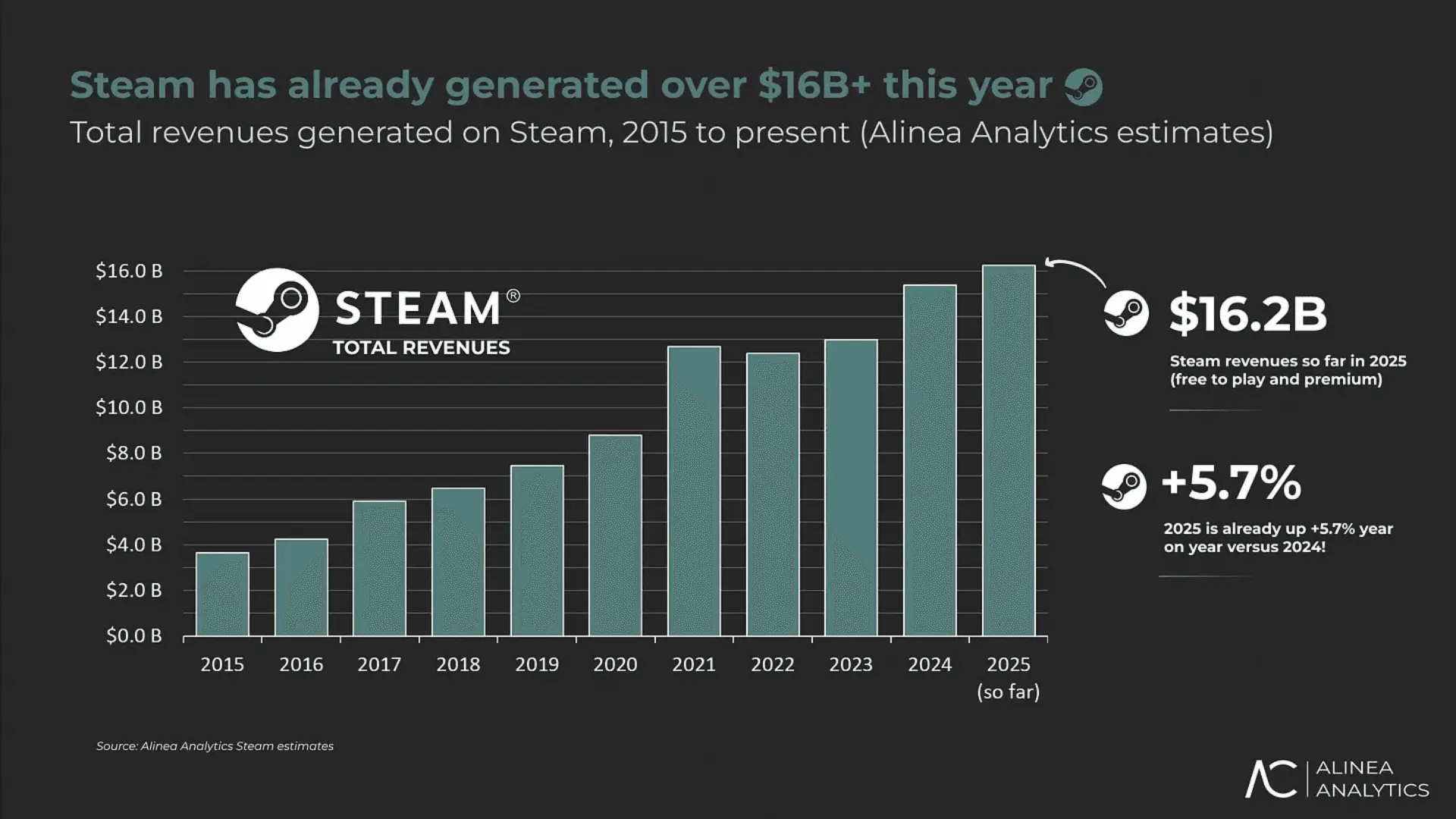As reported on by Alinea Analytics, Valve has officially revealed the Steam Machine, a console-like PC designed for living-room gaming, set to release in 2026. Following the modest success of the Steam Deck, the new device represents the next step in Valve’s effort to expand the Steam ecosystem and provide players with more ways to access games and content. With hardware roughly comparable to a PlayStation 5, though slightly weaker, the Steam Machine is aimed at both existing Steam users and console players curious about PC gaming.
The Steam Machine is not intended to be a mass-market product in its initial release. Instead, it is designed to give current Steam users a streamlined way to play on the big screen and make in-game purchases. Around 20% of Steam Deck owners already connect their handhelds to a dock for TV gameplay, suggesting there is demand for a more powerful, dedicated living-room option.
Valve’s Focus on Software Revenue
The Steam Machine continues Valve’s focus on software and ecosystem revenue rather than hardware profits. The company is likely to sell the device at low margins, similar to the Steam Deck, relying on increased engagement in the Steam store to generate income. Steam has already generated an estimated $16.2 billion in revenue this year, with Valve taking a 20% to 30% cut of game sales depending on the revenue bracket. Each new Steam Machine sold represents a new point of contact for the platform, potentially increasing purchases of games and in-game content.
Intended Audience and Use Cases
The Steam Machine targets multiple groups. Existing Steam users seeking a living-room experience can use it as a secondary device without building a full PC. Console players may see it as a simplified introduction to PC gaming, offering flexibility without the complexity of traditional hardware. Unlike a standard PC, the Steam Machine does not require driver installations, extensive setup, or multiple cables, making it more accessible for a wider audience.
Pricing and Market Position
Pricing will be critical to the Steam Machine’s adoption. Analysts suggest a base price around $400, with higher-capacity versions priced slightly above that. By remaining competitive with consoles like the PlayStation 5 and Xbox Series X, Valve can position the Steam Machine as an affordable entry point for mid-range PC gaming while attracting console players seeking a living-room setup.
Features Compared to Consoles
The Steam Machine offers features that differentiate it from traditional consoles. Steam does not require a subscription for online multiplayer, and regular sales and events make games more affordable. The platform also provides access to a large library of indie and AAA games, including Valve’s own franchises like Counter-Strike 2 and Dota 2. In addition, the device retains the flexibility of a PC, supporting mods, multiple storefronts, third-party peripherals, and emulators, giving players more control over their gaming experience than a standard console.
Challenges for Valve
Despite its advantages, the Steam Machine faces challenges. Software compatibility remains an issue, particularly for games with anti-cheat systems that may not run on the device. Hardware limitations, such as the 8GB VRAM, could affect high-end 4K performance. Valve also lacks a strong retail presence, relying heavily on digital marketing and discoverability within the Steam ecosystem, which may limit exposure to a broader audience.
Competition and Timing
Valve’s move comes at a time of change in the console and PC market. PlayStation is exploring portable devices and potentially a PC launcher, while Microsoft continues to pivot Xbox toward PC-friendly experiences. The Steam Machine may appeal to console players looking for a PC-like experience, leveraging Steam’s dominant storefront and established software infrastructure. This positions Valve as a potential leader in the emerging “ecosystem war,” where platform engagement may be more important than hardware sales.
The Future of Living-Room PC Gaming
The Steam Machine is not intended to outsell PlayStation or Nintendo hardware. Its purpose is to strengthen the Steam ecosystem by providing another way for players to engage with games and content. By offering a flexible, accessible alternative to consoles, Valve aims to attract new players and retain existing ones, expanding the reach of PC gaming in living-room settings.
Source: Alinea Analytics
Frequently Asked Questions (FAQs)
What is the Steam Machine?
The Steam Machine is a console-like PC from Valve, designed for living-room gaming. It runs SteamOS and allows players to access the Steam library on a TV with a simplified setup.
When will the Steam Machine be released?
Valve plans to launch the Steam Machine in 2026, though an exact date has not been confirmed.
How powerful is the Steam Machine?
The device has hardware roughly comparable to a PlayStation 5, though slightly weaker. Valve claims it is six times more powerful than the Steam Deck.
Who is the Steam Machine for?
The Steam Machine targets current Steam users who want a living-room setup and console players interested in PC gaming without building a custom rig.
How much will the Steam Machine cost?
Analysts suggest a base price of around $400, with higher-capacity versions priced slightly higher. Pricing aims to compete with current-generation consoles while remaining accessible.
Can the Steam Machine run Windows games?
Yes. Using Proton, most Windows games can run on SteamOS, although some anti-cheat-protected games may have compatibility issues.
Will the Steam Machine replace consoles?
The Steam Machine is not intended to replace consoles. Its main purpose is to expand the Steam ecosystem and provide a flexible PC gaming option in the living room.




